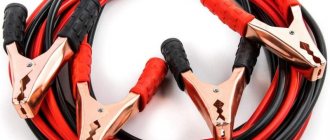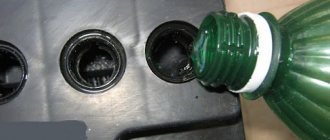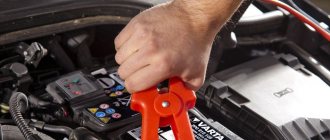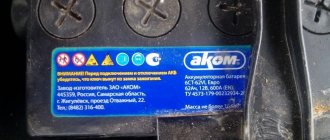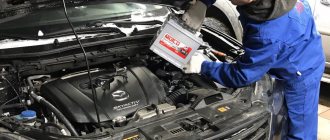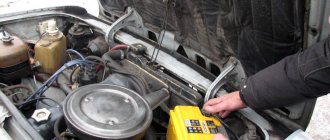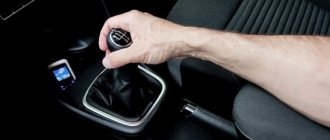Without a charged and serviceable battery, it is impossible to start a car engine - an elementary truth that is known to every car enthusiast. There are two scenarios for the battery, besides breakdown - partial or complete discharge. If at partial charge it can be recharged on the spot, then what should you do when the battery runs out?
What happens during a discharge depending on time and during a deep discharge in general
When the battery is fully charged, the voltage is 12.7V. A decrease in voltage to a value of 10.5-11V is considered to be a strong discharge, at which the car may not start. If the voltage drops to 0.1-0.9V, then this is a complete discharge.
Deep discharge leads to the following negative consequences:
- The electrolyte changes density by absorbing sulfuric acid.
- Salt deposits occur on the walls and lead of the battery.
If you charge, the absorption of acid will stop, and instead, distilled water in the electrolyte solution will begin to be absorbed.
Important! After a deep discharge, the charging cycle must be repeated twice, only in this case the acid salts will completely dissolve. Otherwise they will prevent contact.
Why you shouldn’t let your battery reach a deep discharge state
First of all, the question is related to the density of the electrolyte, which is ideally 1.27 g/cm3 in the ratio of water and sulfuric acid. As already mentioned, with a deep and prolonged discharge, the acid begins to settle on the electrodes in the form of salts.
But the danger is that deep deposits can remain on the electrodes forever. In this case, the battery may lose up to 30-40% of its original capacity. The process of salt precipitation is called sulfation, and it begins after the voltage drops to 11 V.
Is resuscitation possible?
The battery can only be restored if acid sulfates are removed from the plates. There are a number of ways to do this:
- The plaque can be cleaned off manually by removing the plates from the battery. Afterwards it is necessary to replace the electrolyte. Read what the electrolyte level in the battery should be here.
- You can place the plates in a container with a special liquid - a desulfator. In this case, cleaning will happen instantly.
Important! When working, you must use PPE - rubber gloves and goggles.
Main factors affecting battery performance
During operation, batteries wear out and fail. What can speed up the process, which will lead to a sad fact: your car battery is completely discharged?
- elevated temperature is the cause of corrosion of the plates, as a result of which their active coating is depleted and the electrolyte is depleted;
- electrical overloads - leaving the alarm and telephone on during long periods of parking, standing idle in traffic jams in winter with headlights, a fan, a rear window heater and windshield wipers working simultaneously take more energy than the generator produces. Compressors for inflating tires, brake lights, and a powerful audio system also consume a lot of energy.
- vibration - “bumpiness” slowly but surely shakes off the active substance from the battery plates, so it is especially important to fasten it well and firmly;
- poor care. The battery must be kept perfectly clean - you need to keep the terminals and housing clean, wipe them regularly and monitor the electrolyte level. With an increased density of the electrolyte, the plates will quickly collapse, and with a decreased density, they will sulfate, so the electrolyte will freeze at sub-zero temperatures.
Which batteries are not afraid of deep discharge?
Gel batteries, which use a gel made from a mixture of sulfuric acid and a stabilizer instead of an electrolyte, are not afraid of deep discharge.
Such batteries are used in:
- City and railway transport.
- Alarm systems.
- Computers.
- Water supply systems.
The main advantages of gel batteries include:
- Does not require regular maintenance.
- Work in any geometric position.
- They work with a damaged body.
- They serve for a long time.
- High starting current capacity – stable 12.7 V.
- They are not afraid of a strong discharge.
What to do if the battery is completely discharged
It should be immediately noted that if the battery is completely discharged, it will not be possible to charge locally. To determine the status, all modern batteries have indicators: green - fully charged, black - fully discharged, white - breakdown. The battery is dead, how can I charge it?
You can check the voltage and condition of the battery without indicators:
- Using a voltmeter or multimeter, the voltage at the terminals is determined.
- Using a densimeter, the density of the electrolyte is measured, which should vary in the range from 1.25 to 1.29 g per cm3. In addition, the electrolyte must completely cover the plates.
Important! If the battery is completely discharged, then there is no need to waste time bringing it back to life on the spot yourself. Therefore, you need to maintain your battery in a timely manner.
Why did the new battery discharge to zero overnight after being installed in the car?
If you managed to blame everything on the old power source, then know that this is a grave mistake. Before replacing the battery with a new one, the owner is obliged to check the generator, leakage current, and diagnose the long-lived voltage. What should be the voltage on a car battery without load is the subject of the previous article.
- Car radio. Trivial neglect of installation rules leads to high current consumption when switched off.
Signaling. Cheap equipment often malfunctions, and makeshift power supply negates the advantages of even reliable anti-theft models.
Are you confident in the impeccable competence of the installer of the new head unit? If not, then check the connection diagram of the car radio to the on-board electrical network. A classic mistake is to twist the control yellow and power red positive wires. In this situation, the battery is forced to power the radio processor even after it is turned off.
Is the wiring ok? Then study the typical reasons why a tape recorder exhibits increased appetite:
There are countless cars in which an abnormal alarm suddenly began to take on a life of its own. This is due to the “quality” of the equipment and its “good” connection to the on-board network. It’s best to find out what exactly is wrong with a private auto electrician. It could be a sensor or an incorrectly connected circuit.
Other reasons
The main note for gadget lovers: do not forget to turn off what you have connected. This especially applies to the Bluetooth diagnostic scanner, which is connected to the OBD II port. Well, if you decide to open the factory wiring for the sake of installing, say, a radar detector, then remember - it is not recommended to power the equipment directly from “+”. Start at the ignition switch, build the fuse into the positive branch and there will be much fewer problems. It also happens that no one climbed anywhere, but the quiescent current increased sharply. This can be caused by a malfunction of any standard electrical equipment on board:
- Short circuit in the window lift motor.
- Bluetooth block.
- Pilot systems for monitoring on-board electrical equipment with a single bus (if such a unit is on strike, then the symptoms are immediately visible - for example, some electrical device (headlights, etc.) turns on spontaneously).
How to properly charge a dead battery
The battery will become operational again if you follow all the rules and nuances for recharging it. First of all, it is undesirable to leave the battery to recharge “overnight” if the battery is completely discharged to zero, and all other rules are included in the following list:
- The cover is opened and the terminals are removed. Charging is connected to the “plus” and “minus”, and then electric current is supplied.
Important! Disconnection should be done in reverse order.
- It is necessary to set the charging current to 10% of the capacity. If the charger is capable of delivering a current of 50 A for recharging, then the time for the entire process at 5 A will be about 10 hours.
- It is prohibited to speed up charging by increasing the current. In this case, heating and sulfation will occur.
- If the battery cover cannot be opened (there are such models), then recharging should be given at least 40 hours at a current of 2.5% of the capacity.
Important! It is not advisable to use chargers for fast charging. This modification of the device is highly powerful and a weak battery will not withstand the intense current supply.
Why does the car battery drain quickly when it is parked?
If the battery, fully charged the day before, suddenly refused to turn the starter, then keep in mind that a voracious consumer has entered the on-board network. Without the slightest idea about electricity, it is better to entrust its search to the service station masters. To avoid getting scammed, please note: a friendly technician will definitely ask a few questions about electrical equipment. For example, were the lights turned off at night, or was the radio changed? Well, those who are familiar with a multimeter can do it on their own, and the editors of Autostadt.su will tell you what and how.
How to charge a very low battery
If you follow the correct battery charging sequence, you can significantly extend the service life of even a heavily discharged device. The battery is dead, what should I do?
Charging is performed in the following sequence of actions:
- Distilled water is poured into each container-jar, and the plates should disappear under its level.
- The battery is switched on for recharging with a preliminary calculation of the current strength.
- As soon as intensive formation of air bubbles begins in the containers, the battery must be disconnected from charging for 30-40 minutes.
- The current is reduced by 10 times and the battery is connected to charging again.
- If the appearance of bubbles resumes, then stop for 30-40 minutes and repeat.
How to find out the exact reason why your car battery drains quickly
It is necessary to move from assumptions to repair and adjustment work in tandem with a multimeter. This miracle device will indicate whether the current leakage exceeds the permissible figures. If yes, then with its help you can find out the exact reason why the battery discharges quickly when the car is stationary.
So, grab the multimeter, move the handle to the 200 mA position, remove the negative terminal, and place the probes in the gap between the wire and the battery negative. We fix the value.
Attention! The ignition must be turned off.
So, on a car without external signaling and music, the leakage current should be literally 70-80 mA. Rejected? Then it’s not surprising that your car’s battery drains quickly. Rather, dive into the mounting block and pull the fuses one by one, while measuring the amperage. When the numbers drop noticeably, consider that the gluttonous chain has been found. If this is not observed, then the power circuits remain - the generator, starter and ignition system. First, inspect their contacts and wires. Oxidized terminals and poor insulation contribute to leakage.
Please note that we indicated the normal quiescent current for cars, as they say, from the assembly line. It’s hard to say how much the stuffed version should have. If only because some non-standard security systems in the “auto locked” state consume about 50 mA, while others consume 100 mA. If you want to see the quiescent current on a locked car, hold the hood switch and set the alarm to security mode.
Do not forget that driving short distances in traffic jams leads to chronic undercharging of the battery, especially in cold weather. From which one day the battery will be forced to give up the starter, requiring resuscitation from the mains charger. And not just any way! Each battery has its own charging technology: we have already explained what proper charging of an AGM battery looks like and provided instructions for charging an EFB battery.

